Introduction
Each new collaboration is a new country: no matter how familiar the partners might be, no matter how literate each is in their own professional area, they enter the zone of the unknown. The processes and patterns of meeting, making, debating, shaping, discussing, disputing and finally realising the project all happen on ground no one in the collaboration has ever before trodden; or, at least, haven’t trodden in quite that way. This paper discusses a collaboration in which the participants decided to take the ‘zone of the unknown’, both by adopting a framework they’d not previously used, and by stepping blindly into possibility, hoping/assuming that a project and a process would reveal themselves.
Lorraine is a painter, Jen a poet, and we are also sisters who have been collaborating, off and on, for some years now. An earlier project took the form of fairly conventional Humanities-style research: Lorraine spent time in the University of Melbourne’s Museum of Anatomy, producing drawings; Jen spent time in the research literature, exploring embodiment and death; and the output was a book chapter on visual representations of dead bodies (Webb & Webb 2004). For a later project we worked more closely together, co-designing and curating a group show on world-making, and conducting research interviews with the other artists in the show (Webb & Webb 2011a). Lorraine also contributed paintings, and Jen a poem. As well as our own new work and the exhibition, outputs included a conference paper (Webb & Webb 2011b) and a journal article (Webb & Webb 2013).
For the current collaboration, we opted to trial a different model of collaboration.1 We had been working both together and apart, thinking and making, on the topic of materiality and poetics, and decided to formalise this loose interest: this paper traces the record of our project, with a particular focus on the pragmatics involved this approach. As with our other collaborations, it is marked by operation at a distance: Lorraine lives in New Zealand, Jen in Australia. This means we see each other perhaps once a year, and in those brief moments cram in as much as possible about our ideas, our aspirations, our creative imaginings. For the rest of the year we rely on emails and phone calls — casting frail lines across the Tasman in the hope of building something we have not yet fully imagined. In this we are not alone; many collaborators are separated by space, and some by time. Psychiatrist Serge Tisseron (1994: 36) argues that artists tend to play Freud’s fort-da game, a game of ‘casting and retrieving, of separating and binding’, operating within a network of lines of thought and patterns of movement, all of them carrying evidence of the traces of their origin.
We do, of course, have shared origins, in terms of genetic heritage, memories, experiences and interests. But where our individual disciplines and training are concerned, there is a marked difference — the literary and visual arts have distinctive traditions, trajectories, technologies and practices. This, some scholars note, introduces a point of conflict, as Martine Reid and Nigel Turner observe in their introduction to the Boundaries issue of Yale French Studies:
We are all aware of the narrative history of the disjunction which, from the very beginning, heralds the relation between writing and drawing. Some distant source of ‘good sense’ … decided on the division of sciences and techniques, a vast operation of schize (sharing, division) which should make it possible to settle any kind of dispute by first clearly defining differences. (Reid & Turner 1994: 4)
This ‘disjunction’, they argue, is rather a furphy, since the boundaries between the two forms have always been rather blurred, and over history ‘there is no lack of responses to this arbitrary partition of practices’ (1994: 5). From Horace in 1BCE, with his ‘ut pictura poeisis’ (‘as is painting, so is poetry’),2 and through the centuries since, writers and artists, literary and visual arts, have constantly found points of connection.
Barbara Stafford points to analogy — or ‘the art of sympathetic thought’ — as providing what is needed to ‘forge bonds between two or more incongruities’ (2001: 10); and certainly there are myriads of instances of ‘sympathetic thought’ between the two modes. Stafford depicts the process of ‘creative and tentative weaving together of individuated phenomena’ (2001: 61) — where ideas or objects touch, and move apart, and touch again, so that analogical interaction can build the space in which very distinct modes of practice can connect. We found this a compelling concept, and it led us to the writings of Serge Tisseron who argues that writing and drawing share a material practice and a creative logic in ‘an essential movement by which thought learns how to think itself through’ (1994: 36). That ‘thinking through’ involves mark-making, but also acts of casting out, reeling back in, gaining and discarding, thinking and unthinking. It is thinking through making, where the mind and the eye and the hand and the material collaborate to produce a something.
This is where we start.
Collaboration and conversation
Actually we started a bit earlier. About fifteen years ago, one of us bumped into John Berger’s I send you this cadmium red: A correspondence between John Berger and John Christie (2000). This book is a record of their correspondence, and the collaboration between (principally) a writer and (principally) a painter. It began like this:
13th July ’99
Dear John
It was great to see you again. At the airport, on the way home, I was thinking back to when we first talked about doing something … concerning colour. I remember asking how we could begin: ‘Just send a colour’ .. 3
And other-John (Berger) responds: ‘Dear John — Yes, it’s strange now to see a big book ... Not what we thought of!’; and ends by suggesting a new project on which they might collaborate.
As the title of the book indicates, Christie sent Berger a card in cadmium red, and Berger responded, writing onto the red, finding depths and shadows in that colour; and then Christie responded to that encounter, providing working notes and contexts about red, sending little artist books he was making. Christie and Berger moved on from red to blue to other colours, their correspondence revolving around colour theory, the phenomenology of colour, ways of encountering colour, and ‘the seduction hidden in each colour discussed, in every drawing, in every hand-made book that lost or gained its status as an object depending on how it was seen’ (in the section ‘A shadow of grass’, n.p.). And along the way, in elegant sentences and often expansive letters, they develop their ideas, make pieces of (literary, visual) art, and exchange news about their families and friends. By the end they have a substantial book, with full-colour reproductions of their exchanges, fold-out sections, and the whole flow of the correspondence with Christie’s artist books and Berger’s poems making a rich reading experience.
What particularly interested us was that this book exemplifies collaboration between a writer and an artist (or mostly a writer, mostly an artist);4 it shows how such relationships can spark both creative work, and creative lives; and it presents a model for forming points of connection between the two practices that is neither ekphrastic nor illustrative, but rather (per Tisseron) a ‘casting and retrieving, separating and binding’.
Our decision to work in a similar mode was grounded on our shared (if perhaps too rigid) perceptions of ekphrasis: perceptions based on definitions found across the literature, which typically offer a variant of James Heffernan’s: ‘the verbal representation of visual representation’ (1993: 93). Or, as Murray Krieger puts it — in a passage that echoes Lessing’s distinction between visual and literary art5 — ekphrasis is:
the imitation in literature of a plastic art. The object of imitation, as spatial work, becomes the metaphor for the temporal work that seeks to capture it in that temporality. (Krieger 1967: 107)
This positioning of the two arts contains within it the risk of competition, rather than collaboration; indeed, Heffernan describes ‘the quintessentially ekphrastic struggle for mastery between image and word’ (1993: 186). Barbara Fisher rejects that earlier logic, and writes: ‘Rather than focusing on ekphrasis as either fertile reciprocity or fight for dominance … I present ekphrasis as a form of critical mediation’ (Fisher 2006: 3). But, while this is a compelling perspective, the logic is still that the visual work precedes, and is interpreted, inflected, or mediated by the written work. As Marcelle Freiman writes, ekphrasis is ‘a response that does not necessarily attempt to render, represent, equate, or capture the visual in language’, but nonetheless one that involves ‘writing a poem in response to the visual, temporal and emplaced experience of an art work’ (Freiman 2017).
This is where we depart from ekphrasis: rather than seeing one text as being a point of origin for the other, we opted to work in an analogical relationship. As such, we independently reflected on, and then discussed, the nature of our discrete modes of practice, and the ideas that interested us. And because we had been so taken by the Berger/Christie collaboration, we decided we might try to ‘do a Cadmium Red’ too: send bits of work to each other, and see what emerged; and gradually collaborate (co-labour) on something that would involve both painting and poeting.
To some extent this happened, but rather than beginning, as Berger and Christie did, by exchanging a material object, we began with the personal and the ephemeral: we drew on our shared memories of the family holidays we took each winter on the South African coast; fishing with our father; romping in the backyard pool; our experience of migrating via an ocean journey from South Africa to New Zealand; our subsequent lives on and near water ... What we realised is that water is very important to both of us — as it has been to human beings across history (Leeming 1994: 79) — and so decided it would be our ‘cadmium red’, our generative impulse.
So our project began, as projects often do, in a mix of passion (both of us loving water; both fascinated by the associations it offers); pragmatism (what do our institutions want of us; what will they fund us to do?); and idealism (what compelling idea is moving us both?).
Lorraine prepared this proposal for us to provide to our institutions:
The inception of the project occurred as a result of a collaborative research project undertaken in 2011 between my sister Jen and me. While this project was contingent upon academic collaboration, our focus was (perforce) on the creative practice of others.
This research proposal seeks to explore our commonalities and differences as practitioners in the arts through exploring collaborative practice. We start with the common themes of water and myth as our practices have been separately informed by water as motif; sometimes mined from mythological themes and separately developed as poetic and visual works.
Our intention is to use a collaborative dialogue that the US artist team of Helen Mayer Harrison and Newton Harrison call ‘conversational drift’. Newton Harrison says that this practice enables one to be ‘free’ of dialectical thinking and the need to forge a compromise ‘between two forces of opposition’.
Jen had imagined that their exchanges might deliver the fine sentences and developed thinking found in the exquisite Berger/Christie book, but instead our working notes and exchanges reflect the shorthand, staccato, gestural patterns of communication that are the currency between individuals who are very close to each other — rough ideas, half-finished sentences, aleatory exchanges. This is clear from our first exchange as we set the project in motion:
2/02/2016 [Lorraine]
Hi J, this is as far as I got today … if u have time can u check and add/amend whatever
6/02/2016 [Jen]
This is a really exciting project!! I love love love the way you describe it: the conversational drift, the effect of siblings processing shared memories and experiences. I’ve put comments on the doc – will phone you if you like to talk about next steps. Attached a letter confirming support; I can make any changes you want. Now I’m off to Bris to see the APT8 and to launch my art and human rights book at the gallery.
This is hardly the matter of sophisticated artistic conversation; however, it is an example of conversational drift, a material practice we found to be very productive of generative thought, and one that, in addition, doubled as an analogue for the topic of our project, water.6
‘Conversational drift’ is a term we borrowed from Harrison and Harrison, and it is at the heart of their ecological art practice. The point of applying it, they write, is that it interrupts the business-as-usual processes, and reroutes ways of seeing and established ideas, opening participants out to something previously unexpected, and encouraging ‘the conversation to drift toward innovative and creative solutions to real world problems’ (Adcock 1992: 45, n.1). The term also appears in the literature of communication studies, where it is often identified as a failure in communication between the interlocutors are getting ‘off topic’ (see e.g., Berger & Palomares 2011: 191). For Harrison and Harrison, though, it is precisely the ‘getting off topic’ that is its real value; it is also closely associated with Deleuze and Guattari’s concept of the rhizome and the assemblage, because it is a collaborative dialogue that is productive of new thoughts, and new products.
Charles Garoian develops this, beginning his essay on the topic with these paired quotations:

Garoian continues:
the Harrisons’ conversational drift metaphor constitutes a double articulation that suggests mapping as an extension, a trajectory of environmental sites on the one hand; and, on the other hand, mapping as intensity, density, a subtending process that facilitates ‘a plurality of trajectories’ that is a becoming. (2012: 291)
The term is found extensively in the literature, associated in positive terms with environmental art (see Harrison & Harrison), with ill health in the medical discourse (Talamini & Meeter 2009), with power plays in literary studies (de Kock 2003: 85), and with lack of resolution in communication theory (McHale 2004). But we settled on the positive value of the term; and for us, conversational drift provides an affordance for creative collaboration, enriching and extending the possibilities in a way that is less likely to be delivered by, say, project planning. It is also a comfortable mode of operation for us, since as siblings we communicate effectively at a distance, and work en passant — analogically. In addition, both of us having worked in creative practice for decades, we are at home with uncertainty and incompletion; able to work on the balls of our feet, as it were — poised for change and for the insertion of difference.
Materialities and making
Lorraine’s institution approved her project proposal —
16/03/2016 (Lorraine)
Starting now
Hi Lorraine
Research Application: The Possibilities of Water: a collaboration
Please find attached your approval letter for your research project: The Possibilities of Water: a collaboration.
We wish you all the best for this project.
— and we moved from talking to making. Our first move was to swap some earlier work we had done individually and independently, to put ourselves into each other’s head space: Lorraine sent paintings, Jen sent poems. And then for several weeks we worked with little or no reference to each other. During that period, Lorraine produced several paintings:7
6/06/2016 [Lorraine]
How are you guys in storm battered Aus? As we are rather slack, we didn’t realise what was happening there and having lost our phone down the back of the couch, now can’t phone as it’s got no power. But I took these photos today as they’re what I’ve started working on for our stuff. All are influenced by your pomes in the 2 books I’ve got. Hope you’re all safe! Look after yourselves.
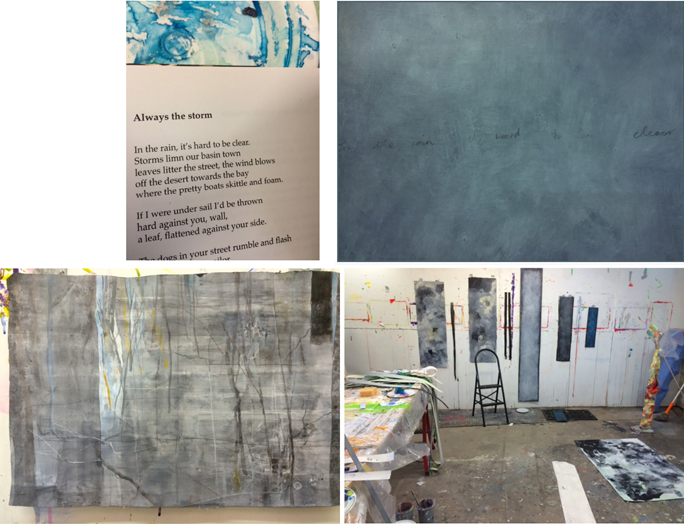
7/06/2016 (Jen)
OMG these are gorgeous! Am compiling some watery poems and will send them asap (heading off on 11 June; taught all weekend on a masterclass; running late to/for everything L ) I love the way you have handwritten words onto one of the images. Talk v v soon – when you find your phone, anyway!
PS: we had rain and a bit of wind; the storm followed the coast.
Clearly this first exchange is operating very much in the mode of meditative interpretation identified by Barbara Fisher as twenty-first century ekphrasis; and initially — despite our insistence that we were not operating in this mode, we did respond directly to the paintings and poems each other submitted. But we also frequently wandered off track:
6/08/2016 [Lorraine]
Btw i can't do water so am expanding ideas based on ur poems or lines therefrom and making experimental painting things. will send pics tonite xx
6/08/2016 [Jen]
Water schwater. I'm doing a small collection of prose poems about red, right now.
6/08/2016 [Lorraine]
ha ha, typical of planning for creative work :)
The following day, Lorraine sent the promised set of paintings:
7/08/2016 [Lorraine]
Hi Sistah attached are some pics hot off the making. The alphabet ones are just begun and examples, the others are also just begun and are called spaintings. The alphabet ones are, I think, the ones that I’ll expand upon with your pomes in mind.
Thinking thinking …
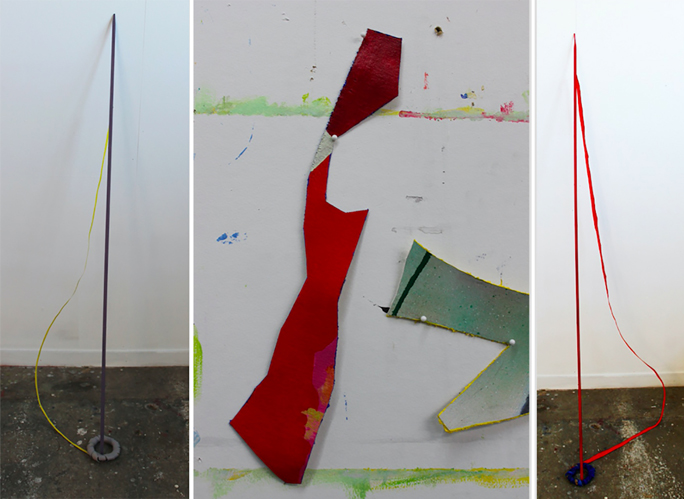
While Lorraine’s works here respond to the idea of letters, words and lines, if not to the content of Jen’s poems, Jen went off on another tangent, writing poems about air and flying. Lorraine, however, returned to the theme of water, and by September had completed another group of images, including:

1725x240 420x1080
Because Jen and her colleagues were hosting a conference in November, she immediately asked Lorraine to send paintings they could exhibit as part of the program. Once the works had arrived, Jen wrote, and sent to Lorraine, the exhibition statement:
Letter and Line
Exhibited as part of ‘Authorised Theft’, the 21st conference of the AAWP, Canberra (November) 2016
These works are part of a larger collaboration between two sisters, one a painter and the other a poet. We are trying to find ways to work together within and across our forms: ways that are neither illustration nor ekphrasis. How does colour speak to word? What is the relationship between a line of poetry and a line of paint? Our first approach to this project is to break with some formal constraints: painting not on canvas but on odd-shaped objects; writing not lineated lyric poetry but prose poetry and fragments. Next is the openness that is a mark of most creative collaborations, a moving to and fro between images, ideas, conversations, essays into objects. In his paper ‘All writing is drawing’ (1994), Serge Tisseron argues:
Neither the paradigm of the eye nor that of language allows us to grasp the meaning of ‘first draft’ dynamics — the moment when its enunciation is born in distinction from what it enunciates. The paradigm of the hand, however, achieves such an understanding.
Working from a similar perspective, we are (in this first instance) more concerned with gestures than with the mark or the gaze, and in thinking through the movement of eye and hand and conversation about how we might make letter that speaks to line, line to letter.
Then, post-installation, Jen sent exhibition images across the Tasman:
27/11/2016 [Jen]
Work in situ, in the lounge area where all the book launches are being held. It's lovely!
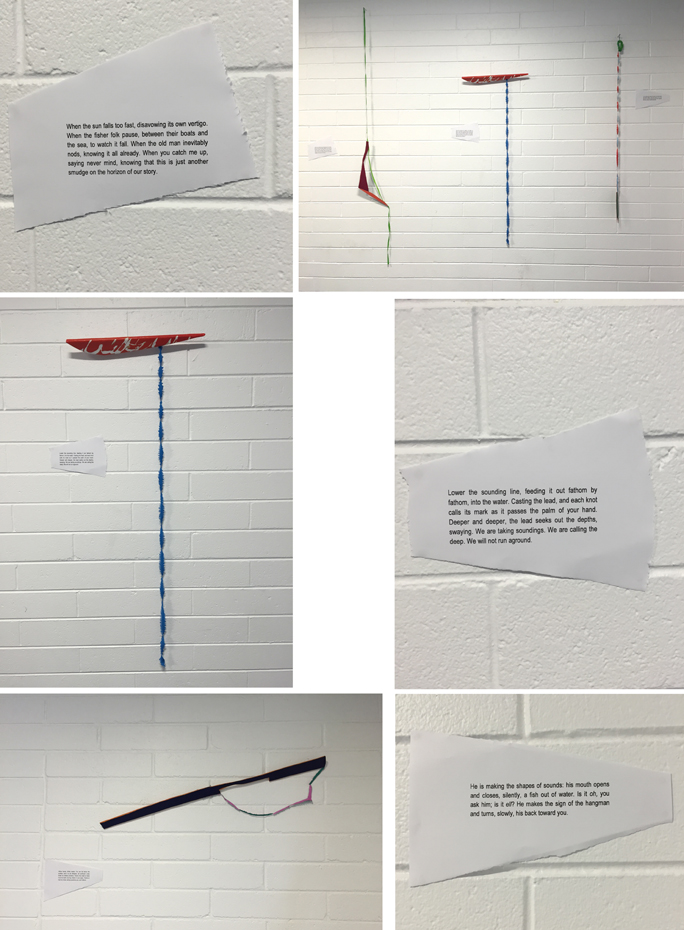
This — effectively a pilot study installation — provided us both with thoughts for ongoing independent practice; and during the Christmas / New Year break both kept working, and talking by phone, as we worked toward the May 2017 exhibition we had planned as the culmination of the project.
Lorraine found her paintings shifting to another orientation, which was a better fit with our initial determination that we would not illustrate each other’s work. She was beginning to produce encaustic paintings, in a more conventional format (landscape and portrait orientation, on canvas), that gestured toward the ideas of water, indeterminacy and openness. And Jen was extending the poems she had prepared for Letter and Line, trying to find a more convincing way in to the idea of water. Consequently:
25/04/2017 [Lorraine]
So I think I’m going to put the show off a bit … will check the gallery calendar tomorrow and see when the next opening is. I’m thinking July/August maybe …I’m not confident that I have enuff work yet and it’s only 3 weeks away (gulp)! A bit more time will be more relaxing … what do you reckon?
The gallery in Whanganui agreed to a later date, and by June Lorraine had a body of work, including drawings in a very watery theme —
13/06/2017 [Lorraine]

—and Jen was writing poems in response:
20/06/2017 [Jen]
these are ones I’ve been playing with after looking a lot at the photos you sent me maybe 6 months ago
My body, your space
1. The blade knows the shape of the scabbard, as the body knows the shape of the blade. In a different world they would be the same thing, undivided. Here, where we live, the blade just wants to find a home, one that fits it right. The body, it thinks, will welcome it in. All it costs the body is a scratch, or the sigh. All it takes is a letting go, and the blade will settle down, and the flesh heals around the haft.
2. You peel back your skin and step out naked onto the floor. Now all that is left is terrain: the cartography of the body, its deserts and its bays, your future scoured in stone.
3. Frayed fabric, scrunched. Like wadding dropped by the surgeon after it has done its job, I say, and you say no, it’s like a relic from some celebrity tomb. You lift it, carefully, and examine it. Like it might know what happened between us last night. It’s the corner of my dress that you tore: isn’t it? I don’t mean to break things, you say. But in your unlucky hand, only fragments survive.
20/06/2017 [Lorraine]
I LOVE … more later in class at the mo
What is evident in the responses we made to each other’s drafts and essays is first that we genuinely like and admire each other’s work, and next that neither made even a gesture toward criticism or analysis of those works; we simply let it function at the level of affect, and drive responsive work without intellectual intervention. This may seem to be at odds with what is known of collaborative practice, which so often is marked by constructive criticism and energetic engagement with each other’s work. Jon Ippolito, in fact, says of his working relationship with Janet Cohen and Keith Frank, ‘Isn’t our entire dynamic based on disagreement?’ (Cohen et al 1999); and in an earlier paper, Jen Webb and Paul Hetherington (2016) explored and analysed not just the affordances but also the fractured and fractious nature of such relationships.
This collaboration, however, took a different path. Because we were not working in ekphrastic mode, seeking to provide neither visual nor verbal representation of the other’s outputs, the collaboration was neither affiliative nor combative; the works we each made do not attempt to embody or perform, or to critique or interpret, each other’s work. Our interaction was always via the logic of conversational drift – of our getting ‘off topic’, heading off on tangents in response to what one or other of us said or made; and gathering the raw material of communication as part of a broader non-dialectic pattern of thinking and making. When one or other of us did feel an impulse to recommend a way of rethinking or of sharpening a work, we did so by phone, talking through what had occurred to us: Lorraine, for instance, urged Jen to make larger poems; and both from time to time returned to conversations about the identity of water, the properties of water, the ethics of reducing water to art.
As we drew closer to the exhibition, it was necessary to move to a professional/public-facing mode of operation, so the conversation shifted from making to exhibiting:
23/06/2017 [Lorraine]
Photos still coming sorry but below is a link to a nice article … and what do you think about the directly-onto-walls poetry? … not sure, … I think it may look too much like written illustration of the paintings if u know what I mean ... https://hyperallergic.com/386454/how-philip-guston-found-salvation-in-poetry/
Time to exhibit
Jen had to travel for work, and then in July returned to Australia and to the project:
16/07/2017 [Jen]
So I'm back in oz now and getting my head back in the one place, and what I am doing is wondering about the exhibition and how you want to display stuff. I could do projection of pomes rather than printing(?) I did that before, and the nice thing about it is that when people walk around the space they get words all over their skin. (But it means messing around with lights, of course). Other ways:
Write directly onto the walls
Print onto sticky-backed material
Print onto tyvek (which could be tiny or huge)
Print onto heavy paper and ring cut into regular shapes and sizes, or tear into chunks
Print onto card
Etc etc etc
Waddyathink?
And a bit later, after some telephone conversations:
21/07/2017 [Jen]
I’ve found a printer who’ll print my pomes on Hahnemuehle rag paper, either the Photo Rag 308gsm (smooth) or the German Etching 310gsm (textured). I like the idea of the textured one. I have 12 pages, I think, but can do more or less, depending what you want. So, I’ve made up A3 pages with about a 140mm column (it’d be cut back to 400mm x 150mm pages), to show you sizes and shapes. there’ll be about 2cm on left and right margins (is that enough?). I’m using Calibri here because it’s narrow and clean and san serif. Font size ranges from 26 to 40.
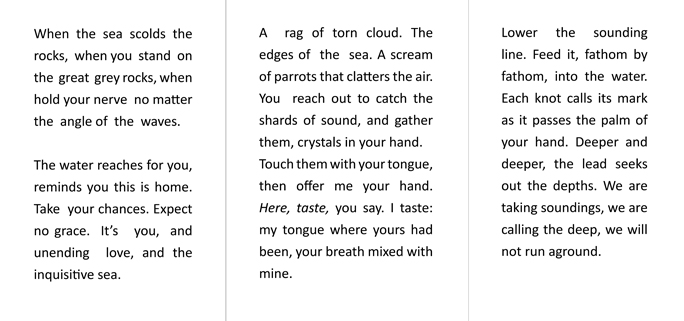
This is hardly the matter of artistic thinking and production, but it is certainly the matter of material practice: how to move from concept and rough sketches to work that is ready to be completed; how to make choices that might result in an unsatisfying aesthetic experience. This changes the mode of practice from art and play to pragmatics — a shift that artists typically adopt when they prepare for exhibition or publication.
27/07/2017 [Jen]
The printing’s done and I'll have it in my hands in a few days, yay. Do you want a catalogue? Maybe A4 folded to DL which gives 6 thin pages: cover sheet, brief statement, images, a bit of a poem, bio notes? I can do that here if you like. Does the show have a title?
This sparked a series of phone calls, resulting in the decision to make a catalogue:
29/07/2017 [Lorraine]
Ok dear Sis. A short profile and below are small jpegs for your perusal … they may all be in the show. Choose which images you like best and I’ll send big pics with names or if names occur to you let me know. The only 2 named so far are (the all white work) called Water Guardian and the other whiteish work called … with HUGE originality … Splash. I’m also finishing off 2-3 more encaustic works with shipping signals ... kind of like this 1st work in the group but not the same

Jen produced a rough draft in InDesign, to which Lorraine responded:
2/08/2017 [Lorraine]
Looks fab ... I’d drop my pic (navigating detail) 1/2 spaces down so there’s a touch more balance between the references, the pic, and the logos but otherwise I love it!!
While Jen completed the edits and layout, and organised printing, Lorraine took on the task of crafting the invitation—
18/08/2017 [Lorraine]

—and Jen travelled to New Zealand to finalise the project and help to hang the show, then returned to Australia, leaving Lorraine with all the final details.
21/07/2017 [Lorraine]
Today photographed the show and put labels up, got the technician to move the light so the show’s properly lit … took catalogues to the book shop organising the poetry festival—they’ve promised to publicise; sadly haven’t yet found a reviewer. Bummer. Will try again tomorrow …
And she attached photographs of works in situ.

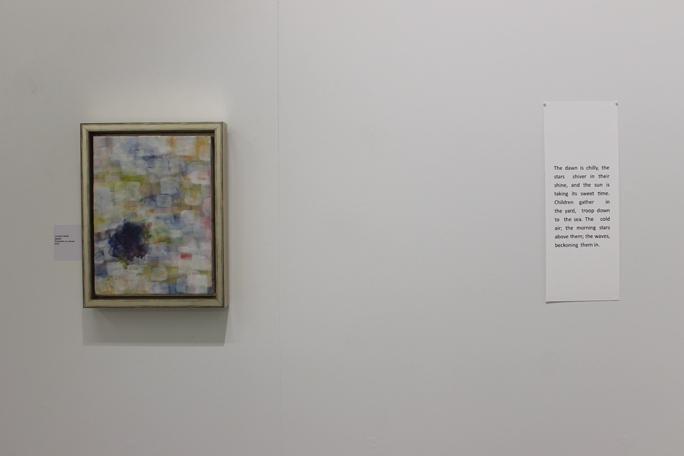
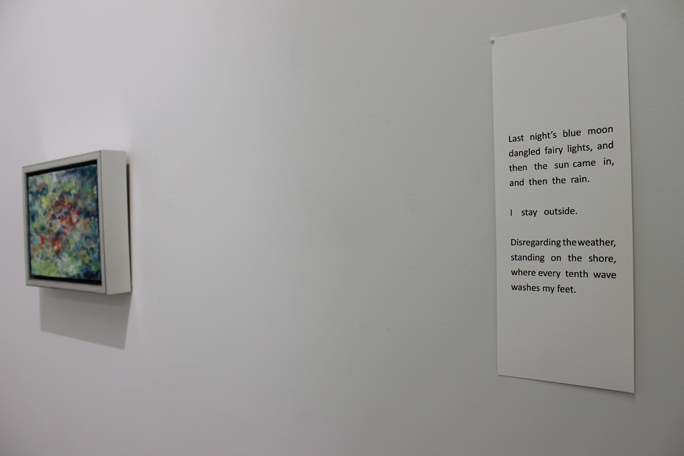
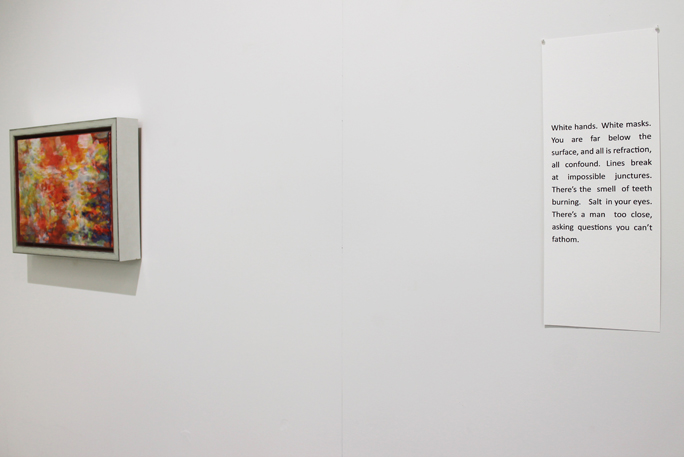
We never did recruit a reviewer but the local media (Wanganui Chronicle, 26 August 2017), at least provided a public record of the exhibition:
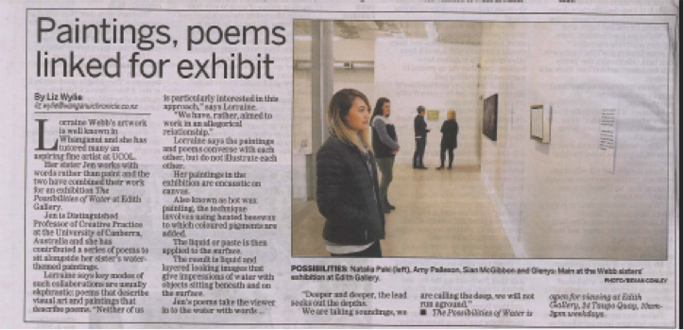
Conclusion
Writing this record of a project and the resulting exhibition reminded us of the constant attention that is demanded, by any creative practice; and of the very fundamental and even banal materialities involved. Each step is characterised by the need to make decisions about process, practice, concept, context orientation; about dimensions and media; about timing and bookings; about the weight of paper, the design of a frame; about how to get things made. We were not collaborating in any conventional way, in as much as we did not write over or illustrate each other’s work, and nor did we participate in their making — not even in the mode of critique. Rather, our approach was to find a way to allow each other to make paintings and poems, to allow those paintings and poems to bump up against each other; to find points of connection between each other and our discrete ways of thinking and making; and to juggle this with the imperatives of everyday life.
But that is simply the practicalities. We did this work because it interested us; because we like doing it; because we like working together. Water provided a point of reference, reminding us perhaps of the fluidity of all human practice, the permeability of the borders that appear around concepts, disciplines and institutions. And certainly, reflecting afterward on the project, the practice and the process, we realised that in all our thinking about it and much of our conversation, we were operating much as water does — finding levels, shifting from zone to zone; and we were operating the way people do around water — dabbling, dipping in and out, keeping heads above, casting lines out to see what we might catch.
This project unsettled our comfortable sense of collaboration, indicating a more open space than we had earlier understood by that practice. We worked so much at armslength, despite exchanging many drafts; we worked uncertainly, ‘drifting’, not knowing what we would exhibit or how we would hang the works until faced with an empty gallery. We can’t say we know any more about water, but we do know a lot more about this – for us – new way to collaborate. We know too that the tendency toward ekphrasis, when working between two forms, is difficult to resist, but that it can be resisted, and that this affords — for us — a more integral collection of works, a collection in which neither literary nor visual takes precedence, but where there is a give and take, a to and fro, an analogical association that leaves us with the sense that the works that made it to the wall belonged there; belonged together; were in conversation with each other.
And at the end, we don’t have a conclusion as such to offer, but rather a point from which to lean into the future and all its affordances; and to do so in the way we like to work — in words and lines and colour and tone. We conclude with a pair of works that were not in the exhibition, but that nonetheless we like:

Notes
1 For a discussion of some of the many modes of collaboration in which contemporary artists engage, see Charles Green The Third Hand. For many analysts, creative practice is necessarily collaborative; see Vera John-Steiner (2015: 42) on ‘the interdependent nature of this basic human endeavor’; see also Webb & Melrose 2015.
2 We are aware that a simple analogy between poetry and painting is not really the import of Horace’s argument. Wesley Trimpi argues that Horace is in fact pointing to ‘a comparable variety of skills’ that are required to produce work of quality in each of the art forms (1973: 9), the importance of the right setting for the presentation of each form (1973: 12), and the capacity of individual works in each form to be sufficiently often seen/heard so that they gain the advantage accorded by familiarity (1973: 14). However, for several centuries it has been widely read as such, and Horace did, after all, establish it as an analogy, so we adopt it, albeit cautiously, as one way of approaching our cross-art collaboration.
3 These quoted sections are set in italics, because in the Berger/Christie book the original handwritten texts are reproduced. We use the same device when, later in the article, we quote our own email exchanges, using italics to render the immediacy of barely filtered communication.
4 Berger is, of course, a painter and photographer as well as a novelist and poet; Christie is, of course, also a book artist and publisher; each is therefore familiar with both visual and literary arts.
5 GW Lessing’s major work on the relationship between painting and poetry identifies the former as a spatial and a static art, the latter as an art of time, with the sequence of word following word, line following line.
6 And, as such, it doubles as a sort of joke.
7 Breaking with precedent, we have not provided captions for the images or the poems included here, because the individual works depicted for the most part they did not have works, being drafts and essays rather than finished objects.
Adcock, C 1992 ‘Conversational drift: Helen Mayer Harrison and Newton Harrison’, Art Journal 51.2 (Summer): 35–45
Berger, CA and NA Palomares 2011 ‘Goals and Knowledge Structures in Social interaction’, in ML Knapp and JA Daly (eds), Handbook of Interpersonal Communication 4th ed, London: Sage, 168–200
Berger, J and J Christie 2000 I Send You this Cadmium Red: A Correspondence between John Berger and John Christie, Barcelona: ACTAR
Cohen, J, K Frank and J Ippolito 1999 ‘Answers and questions about digital collaboration’, Afterimage: Journal of media arts and cultural criticism 27.3 (Nov/Dec)
de Kock, L 2003 ‘Splice of Life: Manipulations of the “Real” in South African English Literary Culture’, Journal of Literary Studies 19.1 (March): 82–104
Deleuze G and Guattari F 1987 Thousand Plateaus: Capitalism and Schizophrenia, trans B Massumi, Minneapolis: University of Minnesota Press
Fisher, BK 2006 Museum Mediations: Reframing Ekphrasis in Contemporary American Poetry, London, New York: Routledge
Freiman, M 2017 ‘Ekphrasis as Enactment: Towards a poetics of contemporary diaspora practice’, Axon: Creative Explorations 7.2 (December) at http://www.axonjournal.com.au/issue-13/ekphrasis-enactment (accessed 30 December 2017)
Garoian, CA 2012 ‘Sustaining Sustainability: The Pedagogical Drift of Art Research and Practice’, Art Research and Practice, Studies in Art Education 53.4: 283–301, at
http://dx.doi.org/10.1080/00393541.2012.11518870 (accessed 30 December 2017)
Green, C 2001 The Third Hand: Collaboration in Contemporary Art from Conceptualism to Postmodernism, Minneapolis: University of Minnesota Press and Sydney: UNSW Press
Heffernan, J 1993 Museum of Words: The Poetics of Ekphrasis from Homer to Ashbery, Chicago: University of Chicago Press
Horace [Quintus Horatius Flaccus] 1929 [19BCE] Satires, Epistles, the Art of Poetry (trans H Rushton Fairclough), Cambridge MA: Harvard University Press
John-Steiner, V 2015 ‘Creative Engagement across the Lifespan’, in Vlad Petre Glăveanu, Alex Gillespie and Jaan Valsine (eds), Rethinking Creativity: Contributions from Social and Cultural Psychology, Hove: Routledge, pp.31–44
Krieger, M 1967 ‘The Ekphrastic Principle and the Still Movement of Poetry: or Laokoön Revisited’, in The Play and Place of Criticism, Baltimore, MD: Johns Hopkins Press, 105-12
Krieger, M 1967 ‘Ekphrasis and the Still Movement of Poetry; or Laokoon Revisited’ in M Krieger 1992 Ekphrasis: The Illusion of the Natural Sign, Baltimore: Johns Hopkins UP, 263–88
Leeming, D with M Leeming 1994 A Dictionary of Creation Myths, Oxford: Oxford University Press
Lessing, GE 1984 [1766], Laocoön: An Essay on the Limits of Painting and Poetry (trans EA McCormick), Baltimore: Johns Hopkins University Press
McHale, JP 2004 Communicating for Change: Strategies of Social and Political Advocates, Lanham: Rowman & Littlefield
Reid, M and NP Turner (1994) ‘Legible/Visible’, Yale French Studies 84, Boundaries: Writing & Drawing: 1–2
Stafford, BM 2001 Visual Analogy: Consciousness as the Art of Connecting, Cambridge MA: Massachusetts Institute of Technology Press
Talamini, LM and M Meeter (2009) ‘Dominance of Objects over Context in a Mediotemporal Lobe Model of Schizophrenia’, PLOS ONE 4.8: e6505. at https://doi.org/10.1371/journal.pone.0006505 (accessed 30 December 2017)
Tisseron, S 1994 ‘All Writing is Drawing: The Spatial Development of the Manuscript’, Yale French Studies 84, Boundaries: Writing & Drawing: 29–42
Trimpi, W 1973 ‘The Meaning of Horace’s Ut Pictura Poesis’, Journal of the Warburg and Courtauld Institutes 36: 1–34
Webb, J and A Melrose (2015) ‘Writers Inc: Writing and Collaborative Practice’, in Alexandria Peary and Tom C. Hunley (eds), Creative Writing Pedagogies for the Twenty-First Century, Carbondale Ill: Southern Illinois University Press, 102–25
Webb, J and L Webb 2004 ‘Dead or alive’, in E Klaver (ed), Images of the Corpse, Madison: University of Wisconsin Press, 206–27
Webb, J and L Webb 2013 ‘Making Worlds: Art, Words and Worlds’, Journal of Humanities Research XIX.2: 61–80
Webb, J and P Hetherington 2016 ‘Slipperiness, strange attractors, and collaborative sociability’, Axon: Creative Explorations 6.1 (March), at http://axonjournal.com.au/issue-10/slipperiness-strange-attractors-and-collaborative-sociability (accessed 30 December 2017)
Webb, L and J Webb (2011a), Making worlds, curated exhibition with catalogue, Whanganui, New Zealand: Edith Gallery, June-July
Webb, L and J Webb (2011b) ‘Making Worlds: art, ethics and materiality’, The World and World-Making in Art: Connectivities and Differences, ANU, Canberra, August